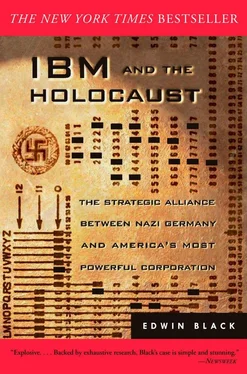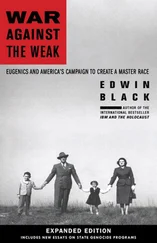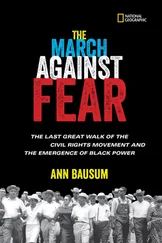* * *
WHEN HITLERcame to power, in January 1933, he made an open promise to create a Master Race, dominate Europe, and decimate European Jewry. Num-berless racial laws—local and national—appeared throughout the country. Jews could no longer advertise in the phone book or rent stalls in the markets. Thousands were terminated en masse from their employment. Even Jewish-owned companies were forced to fire their Jewish employees. 93
Hitler’s paper pogrom was the dull edge of the knife. The sharp edge was violence. Unrestrained acts of depraved Nazi brutality against Jews and other undesirables began at once, often in full view of newspapermen and photographers. Windows were broken. Jews dragged from their homes and shops were paraded through the streets with humiliating signs hung around their necks. Some were forced to wash the streets with toothbrushes. Not a few were kidnapped and tortured by Nazi gangs. Police looked the other way. On March 20, 1933, a concentration camp for political enemies was established at the pastoral town of Dachau, ten kilometers north of Munich. Many others soon followed. Scores of Jewish merchants in Essen and Muen-ster were delivered wholesale to the infamous camps. In Frankfurt, thousands of frenzied Storm Troopers paraded through the streets chanting, “Kill the Jews.” A London newspaper actually published a Berlin street map locating a dozen Nazi torture houses. 94
By April, some 60,000 Jews had been imprisoned and 10,000 more had fled the country, appearing as refugees throughout Europe and America. Professional associations were expelling their Jewish members. Signs were hoisted in front of hotels, restaurants, beaches, and sometimes even at the edge of town: “Jews Not Wanted Here.” Jews were being swiftly driven into economic and social exclusion as a first step. 95
Newspapers and radio broadcasts throughout the western countries declared Hitler a menace to world peace and indeed world civilization. The world reacted with boycott and protest movements springing up everywhere. Led by the Jews of New York and London, but supported by men and women of conscience from all faiths and all nations, boycotters and protesters noisily made sure that no one was unaware of the atrocities in Germany. 96
On March 27, some 20,000 protesters gathered at a monster Madison Square Garden demonstration in New York that was broadcast around the world. Within days, similar rallies and sympathetic movements appeared in Paris, Istanbul, Toronto, Bombay, Warsaw, and London. In Salonika, 70,000 Greek Jews assembled to launch their anti-Hitler movement. 97
Whether in Bucharest, Antwerp, Chicago, or Belgrade, a growing world movement would not stand by passively as Jews were being targeted. Anti-German boycott and protest actions erupted across the globe. The anti-Nazi boycott systematically identified merchants who imported German goods and forced them to stop by public pressure tactics. Whether it was small shops selling German china and camera film, or tourists sailing across the Atlantic on German vessels, outraged boycotters demanded they switch—or face a retaliatory boycott. 98
Nor was energetic support for the whole idea of anti-German boycott the province of mere agitators. A Depression-wracked world was eager to replace the Third Reich’s economic niche. Commercial interests and labor unions everywhere saw the anti-Nazi movement as one they could eagerly join for both moral and business reasons. 99
On May 10, 1933, more than 100,000 marchers, businessmen and unionists alike, Jews and Christians, jammed midtown Manhattan. Newsreel cameras mounted on platforms filmed evocative scenes of anti-German placards in the air amid a backdrop of furling American flags and crowds loudly demanded that “in the name of humanity” all businesses stop doing business with Adolf Hitler. 100
The question confronting all businessmen in 1933 was whether trading with Germany was worth either the economic risk or moral descent. This question faced Watson at IBM as well. But IBM was in a unique commercial position. While Watson and IBM were famous on the American business scene, the company’s overseas operations were fundamentally below the public radar screen. IBM did not import German merchandise, it merely exported American technology. The IBM name did not even appear on any of thousands of index cards in the address files of leading New York boycott organizations. Moreover, the power of punch cards as an automation tool had not yet been commonly identified. So the risk that highly visible trading might provoke economic retaliation seemed low, especially since Dehomag did not even possess a name suggestive of IBM or Watson. 101
On the other hand, the anticipated reward in Germany was great. Watson had learned early on that a government in reorganization, and indeed a government tightly monitoring its society, was good news for IBM. During the Depression years, when the Franklin D. Roosevelt Administration created a massive bureaucracy to assist the public and control business, IBM doubled its size. The National Recovery Act of 1933, for example, meant “businesses all of a sudden had to supply the federal government with information in huge and unprecedented amounts,” recalled an IBM official. Extra forms, export reports, more registrations, more statistics—IBM thrived on red tape. 102
Nazi Germany offered Watson the opportunity to cater to government control, supervision, surveillance, and regimentation on a plane never before known in human history. The fact that Hitler planned to extend his Reich to other nations only magnified the prospective profits. In business terms, that was account growth. The technology was almost exclusively IBM’s to purvey because the firm controlled about 90 percent of the world market in punch cards and sorters. 103
As for the moral dilemma, it simply did not exist for IBM. Supplying the Nazis with the technology they needed was not even debated. The company whose first overseas census was undertaken for Czar Nicholas II, the company Hollerith invented in his German image, the company war-profiteering Flint took global, the company built on Thomas J. Watson’s cor-rugated scruples, this company saw Adolf Hitler as a valuable trading ally.
Indeed, the Third Reich would open startling statistical venues for Hollerith machines never before instituted—perhaps never before even imagined. In Hitler’s Germany, the statistical and census community, overrun with doctrinaire Nazis, publicly boasted about the new demographic break-throughs their equipment would achieve. Everything about the statistical tasks IBM would be undertaking for Germany was bound up in racial politics, Aryan domination, and Jewish identification and persecution.
* * *
WHEN HITLERrose to power, German intellect descended into madness. The Nazi movement was not merely a throng of hooligans pelting windows and screaming slogans. Guiding the Brown Shirts and exhorting the masses was an elite coterie of pseudo-scientists, corrupted professionals, and profit-blinded industrialists. Nazi jurists, medical doctors, and a clique of scientists—each with their prestigious academic credentials—found ways to pervert their science and higher calling to advance the cause of Aryan domination and racial persecution.
At the vanguard of Hitler’s intellectual shock troops were the statisticians. Naturally, statistical offices and census departments were Dehomag’s number one clients. In their journals, Nazi statistical experts boasted of what they expected their evolving science to deliver. All of their high expectations depended on the continuing innovation of IBM punch cards and tabulator technology. Only Dehomag could design and execute systems to identify, sort, and quantify the population to separate Jews from Aryans.
Читать дальше












